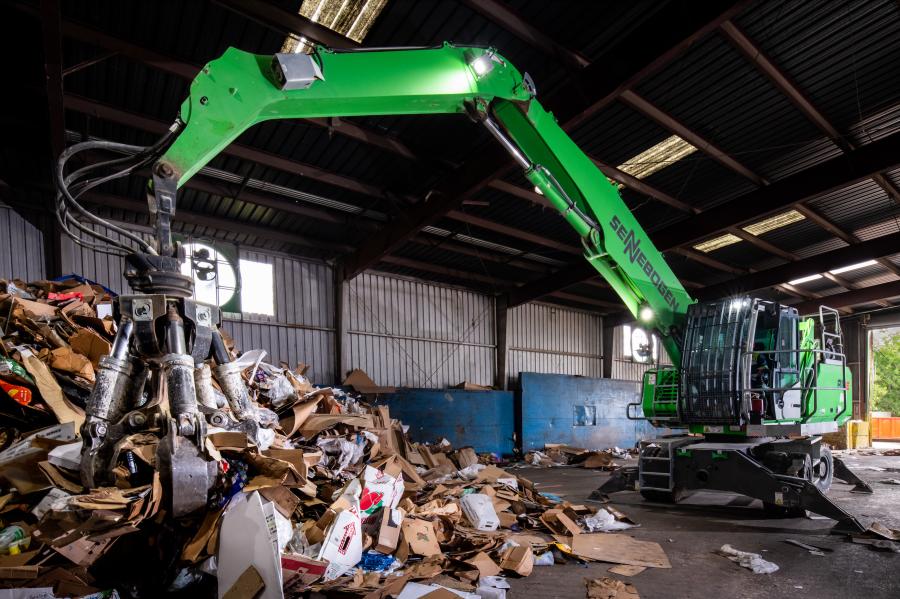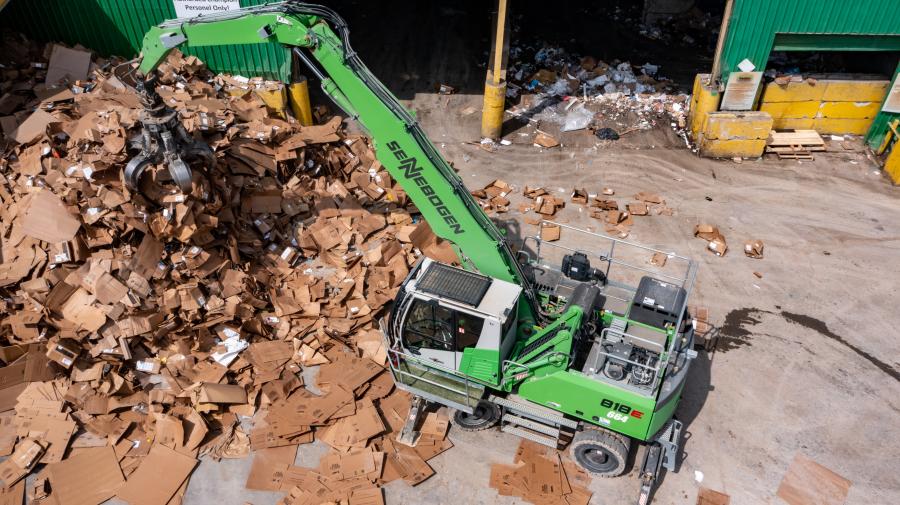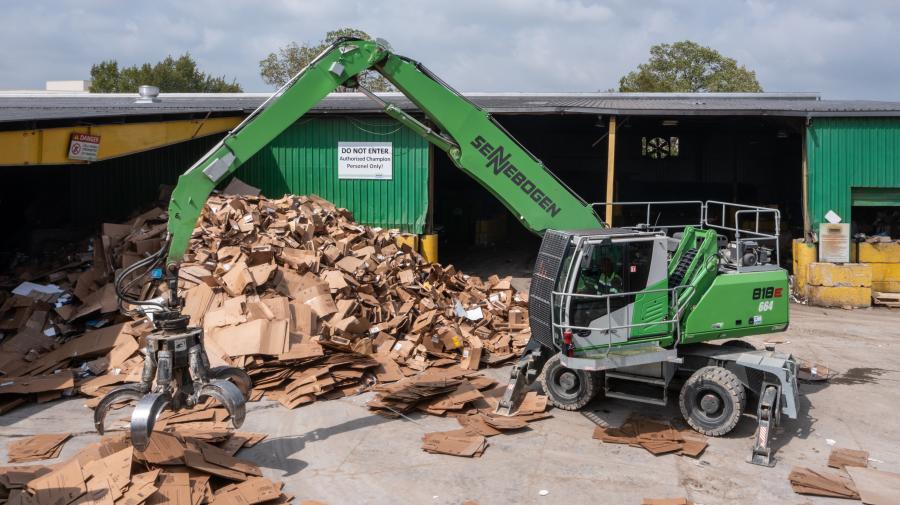Champion Waste & Recycling Services uses SENNEBOGEN material handlers at its facility in Dallas.
In 2015, Paul Kuhar was deep into the opening of his new MRF facility designed specifically for processing C&D waste. It's no coincidence that this was the same year he started to switch his loading equipment from traditional excavators to SENNEBOGEN 821 M purpose-built material handlers.
Kuhar, vice-president of Champion Waste & Recycling Services, put his first SENNEBOGEN to work at the firm's commercial MRF in Dallas. Two more SENNEBOGEN machines were quickly deployed to the new plant north of the city.
"With an excavator, you're basically at ground level. So, you're having to lift material high up in the air to load inside a trailer or into a conveyor belt. Even if you have spot mirrors and things like that, you really don't have the visibility an operator needs."
Bird's-Eye View
Champion, a family-owned business, has been operating for more than 20 years. Kuhar personally has worked in the waste and recycling industry for 27 years, but he continues to explore new ways to improve his processes.
"We did everything we could when we started, to ensure, you know, the guys had some good visibility. We tried putting the excavator on a pad four feet high to give them a little more height. We put in some big spot mirrors. But you still have that level line of vision, so you really can't see up and above.
"Having that SENNEBOGEN cab raise the operator up gives him a really good bird's-eye view inside the trailer and inside the loading hoppers of the conveyors. He also gets a good view of the tip area and the processing areas. He can be really meticulous on pre-sorting material; if he sees something like a big piece of concrete in the waste stream, he can pull it out."
"A No-Brainer" to Switch
Switching to material handlers also opened up new choices for the "business end" of the machine. Champion uses three types of attachment on their SENNEBOGEN material handlers. They can be exchanged quickly to suit different applications within the operation: a clamshell grab; a small, fixed grapple; and a larger orange-peel grapple with the 360-degree rotation.
Kuhar said operators were a bit skeptical of changing from the equipment they were familiar with, but now appreciate the flexibility it gives them.
"What the guys really like about the rotating grapple is that they can grab material, and they can essentially fluff it to tidy it as they load. If we get material that's wrapped with banding or plastic wrap, for instance, they can spin and get it to a point so that it can be loaded safely and correctly. Now, you'll see them use that capability throughout the day; they're constantly spinning. We have great people; they can pick out a piece of cardboard the size of a small Amazon box out of a pile. I mean they're really, really that good.
"With the elevated cab and the flexibility of the grapple attachments, it was a no-brainer for us to switch."
Making a Difference
The first three units that Champion purchased were used machines. Those have since been upgraded with new models on lease from SENNEBOGEN. Kuhar said the company's investment is paying off through every aspect of their operations, from the infeed to loading outbound trucks.
"Once the operators are trained and they know how the machine works, it's just consistent, fluid movement. They can anticipate every move they're making because they can see what they're doing.
"The biggest difference is at the infeed. We could be running 25-plus tons an hour. With an excavator, either you're going to overload the screen or underload it.
"You get a lot of empty conveyor belt going through the plant. With the SENNEBOGEN, we're able to keep the flat infeed part consistently loaded, which loads the screen evenly, maximizing the input feed. As the operator is moving material, he can spread it within the pile, crushing it up a little bit, or feather out the stream.
"On the outbound side, loading residuals, metals and woods, you see a noticeable difference. Walking floor trailers have those crossbeam bars up top, and if you're using an excavator, you can't see them. We had to mark the side of the trailers with paint to show where they were. But in the SENNEBOGEN, you can see up and over, and it's literally just hand-in-glove. You can really finesse the loading in those things. We've run over 6,000 tons a month out of this one particular plant."
Safety, Savings
The precision and flexibility of the SENNEBOGEN 821 material handlers also is saving wear and tear on Champion's other equipment. The infeed suffers fewer jams as the operator can see and pick out a problem before it gets lodged in the screens. Awkward loads can be adjusted to go into the trailers perfectly level without hitting the sidewalls while maximizing the trailer's capacity.
"That's a big advantage," said Kuhar. "An excavator using a thumb bucket or a three-over-two bucket is very two dimensional. You can't turn anything. You just drop. If you have something splintered, there's the potential that you're going to hit the sidewall or puncture it.
"We run close to 20 walking floors ourselves and then we have third-party truck guys coming in. We don't want to tear apart our own equipment, of course, but for them, it's a huge deal. That's how they're making their money. The visibility in the SENNEBOGEN with the grapple we have on it was a game changer. It was a big thing for us to make sure that their equipment was taken care of as well and they appreciate it."
LEED Benefits
Kuhar and colleagues are keenly aware of his company's role in environmental initiatives. Their LEED Green Associates work with clients to design, implement and divert building materials from the landfill. SENNEBOGEN equipment helps them to meet their LEED goals.
The 821 M is a 52,800 lb. machine powered by a 141 hp Cummins engine. Purpose-built for lifting applications, these waste handlers run with engines considerably smaller than excavators that are optimized to work below grade.
"With the cost of diesel, you want to be as efficient as you possibly can," said Kuhar. "The horsepower and the size of the engine on the material handler are both a lot less than in an excavator."
The aptly named green machines use fuel more sparingly to do the job they are designed to do, which means lower costs per operating hour as well as lower emissions.
The picking and sorting capabilities of the 821 material handlers further serve the LEED goals of C&D customers. Precise metering of varied materials going through the plant processes and into outbound trucks allows Champion to increase rates of recovery and recycling of clean material, and to provide detailed documentation required to earn LEED benefits.
Options for Future
Still looking ahead for his company, Kuhar is open to a change in equipment for Champion's future ventures. The current SENNEBOGEN waste handlers are all diesel powered, rubber-tired machines. When he spoke to SENNEBOGEN's Texas distributor, ASCO, the possibility of mounting them on an elevated pedestal was discussed.
According to Kuhar, "Our guys were like, ‘No, we don't want to do that.' They like the versatility and flexibility to move the machine out of the floor and take it over to a different part of the plant. So, we said, okay, we'll keep them mobile and keep them versatile."
As he considers an upgrade to the commercial MRF in Dallas and with plans to open an organic facility, the change in application could lead to a change in SENNEBOGEN platforms. Dedicating a waste handler to do a specific task in a set location re‑opens the potential for a pedestal-mounted 821. Kuhar also is open to electric-drive versions of the 821, either in fixed or mobile configurations.
"If all it's going to do is load the system, then heck, we have juice here so let's run electric. Obviously, there are a lot of benefits to that over diesel. I'll be very interested to see the options."
Whatever the future holds, the discussion of excavators vs. material handlers is over at Champion.
"I tell people all the time," said Kuhar. "You know, we've done both. I can tell you that I have zero hesitation about recommending a material handler."
This story also appears on Aggregate Equipment Guide.
Today's top stories
















